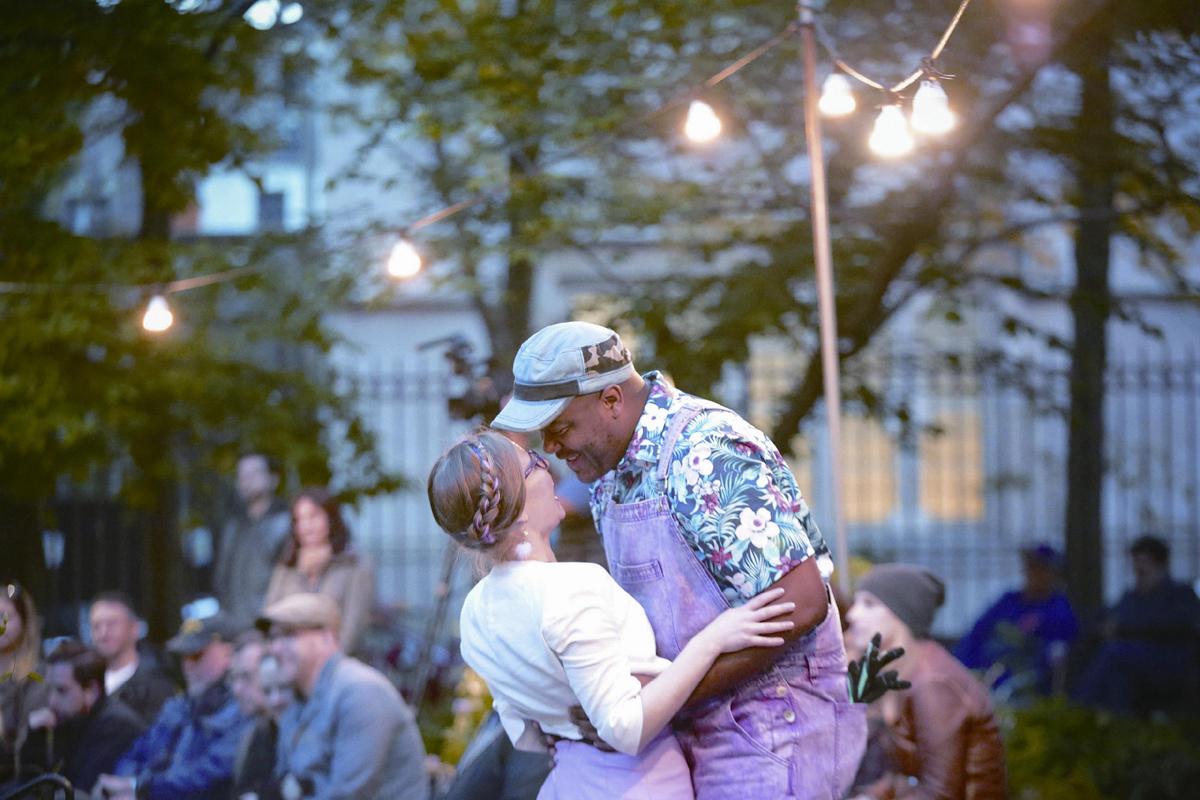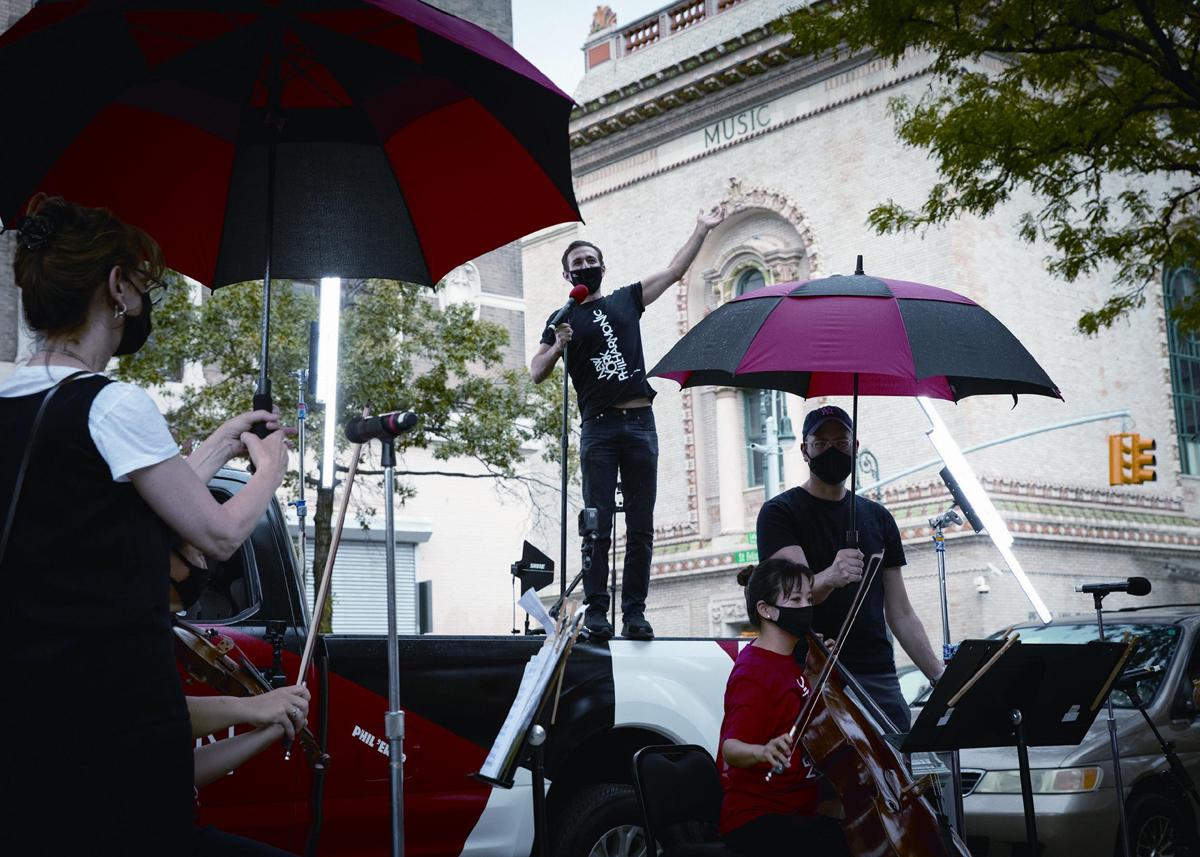户外歌剧演出:新冠疫情反击战
2020-03-17司马勤
司马勤
有时候,伟大的想法往往生不逢时。10年前,纽约市立歌剧院倒闭前的最后一位总监乔治·斯提尔(George Steel)沦为众矢之的,因为他为了节省经费,把心一横,决定让歌剧院从多年常驻的林肯中心搬离。后来,埃里克·爱因霍恩(Eric Einhorn)和杰西卡·克里格(Jessica Kriger)建立现场歌剧团(On Site Opera)的方针,也套用了同样的“游牧”演出方式——每一部制作上演时,都会选用城里比较独特的、但适合作品主题的不同场地。
我们也可探究作曲家大卫·朗(David Lang)的个案:费城医学院(College of Physicians of Philadelphia,注:这个机构重在推广医学文化,而并非聚焦于具体的教学)为了纪念1918年“西班牙流感”暴发一百周年,邀请大卫·朗撰写新曲。这首名为《为了防疫,保护自己》(protect yourself from infection)的作品应运而生,合唱团把美国政府于1918年颁布的防疫健康指南中的文本唱了出来,妙语连珠。这部作品于去年首演——正是全球新冠疫情暴发之前。
由此可见,一些本来看上去离奇古怪,甚至看起来像自我毁灭般的举动,后来可能就变得有如神来之笔。大卫·朗这部合唱曲在今年突然变得极合时宜——甚至还衍生了一部网上流传的音乐短片,用以宣导今天全世界人们都熟知的防疫措施(1918年的防疫健康指南中劝诫我们“避开人群”,以及“不要到剧院、电影院或其他公众聚集的地方”)。如今,表演艺术机构别出心裁地维持曝光度,是必然也是必需的。如果平常演出的场地长期关门,你不得不想办法找个出路。
在今年已经过去的大半年里,我们所知道的歌剧已经被各种歌剧未来会变成什么样的猜测所取代,至少在疫苗成功研发前会是这样的:观众以及剧场工作者(包括后台工作人员)需要保持社交距离;剧场的上座率只能保持在低位;布景道具尽量简单尽量少用,多媒体投影最为安全,因为接触实物布景的表面会增加感染病毒的机会。
以上各个论点勾起了我的一些回忆:第一,北京国家大剧院著名的《托斯卡》歌剧制作中,因为偌大的舞台,在女主角大声警告猥琐的斯卡皮亚“不要走过来”时,两人相距起码15米;第二,今年夏天开始,防疫卫生警告中就反反复复地提示民众“户外要比室内好”。
想当年我刚搬到纽约,这个文化重镇不仅有大都会歌劇院在各大公园举行歌剧音乐会,还有纽约大歌剧院(New York Grand Opera)在中央公园制作的大型户外演出。这显然是一个季节性的现象,因为在数九寒冬,没有一个神智正常的人会坐在户外看歌剧演出(更不用说在户外表演了)。至于社交距离,大都会每次举行免费演出,公园的大草坪上都会塞满成千上万的市民。我也回想起近年来举行的露天歌剧演出:哥谭市室内歌剧院演出丹尼尔·卡坦(Daniel Catán)撰写的《拉伯西尼医生的女儿》(Rappaccinis Daughter),在纽约布鲁克林植物园搬演;不久以前,现场歌剧团的莫扎特早期歌剧《假扮园丁的姑娘》(The Secret Gardener),在曼哈顿西区一个社区花园呈现(我看的是网上演出录像,尽管那个花园就在我家附近)。
直至今年疫情之前,歌剧院团避开传统演出场地,一般会被定义为“噱头”或者“浸没式实验”——有时候两者兼而有之,通常还限于艺术节或者小规模的歌剧团。为什么?因为露天演出(以及大自然的阴晴不测)随时会变成策划者的噩梦。小型歌剧团致力于打破传统局面,他们勇于冒险,精神可嘉。可是,较为传统的大型院团需要顾及众多艺术家的生计问题——更重要的是,要面对与艺术家工会的谈判。考虑到当下各个歌剧院面对的大问题:是浪费场馆高达80%的观众席还是寻觅新的操作模式——毫无疑问,许多院团做出了超出常理的选择,决定暂时离开传统的剧院场地。
几天前,我听说刚聘请了夺得“麦克阿瑟天才奖”的尤瓦尔·沙隆(Yuval Sharon)为艺术总监的密西根歌剧院(Michigan Opera Theatre)将于今年10月策划一套瓦格纳制作,为新演出季拉开帷幕,演出地点是一个停车场。几天后,亚特兰大歌剧院(Atlanta Opera)将搬演两部开幕制作——莱翁卡瓦洛的《丑角》与维克托·乌尔曼(Viktor Ullmann)的《亚特兰蒂斯皇帝》(Kaiser of Atlantis),演出将借用亚特兰大一所大学的垒球场交替进行,在那里制作方搭建起一个临时的露天大帐篷。
我应该特别指出,密西根与亚特兰大歌剧院都是相当靠谱的艺术机构。尤瓦尔·沙隆于2018年在拜罗伊特歌剧节担任导演,是首位在瓦格纳“圣地”执导新制作的美国艺术家。这一部《黄昏:众神》(Twilight: Gods)时长只有一个小时(观众将直接开车驶进歌剧院停车场,在自己的车中观看),这个制作往后将移师至芝加哥抒情歌剧院。亚特兰大歌剧院是现场歌剧团《假扮园丁的姑娘》的联合制作方,对户外演出的规划非常严谨,观众座位的设置也十分灵活,而两套歌剧(把合唱团去掉之后)最多只需要6位演员在台上演出。《丑角》的故事本身就发生在一个到处巡演的剧团里,所以把演出安排在大帐篷内十分应景,也不算是故意“耍噱头”。
如我所料,这些制作都会有视频记录,平衡现场演出只可容纳少量观众(即少量票房收入)的问题,寄希望于往后的网上点播可以增加一些收入。现场观众的反应会怎么样,现在很难预测,虽然在过去几周里,纽约乐团的一些举措为我们提供了一些线索。
当新冠疫情促使夏季演出计划统统取消之后,巴德音乐节(Bard Music Festival)重新编排,摇身一变成为了一个虚拟的网络音乐节庆:全部都是现场直播,网上没有视频留存。音乐节的宗旨是把大家熟悉的作曲家与鲜为人知的同行们相提并论。音乐节把本年度的主题聚焦于美国黑人作曲家,直接呼应了今天最令人瞩目的黑人维权运动(Black Lives Matter)。这些年来,巴德音乐节被誉为美国最富有冒险精神的跨学科艺术节。今年夏天,音乐节没有在法兰克·盖瑞(Frank Gehry)所设计的、耗资6200万美元兴建的艺术中心内举行。全部活动移师至音乐节创办初期常用的户外帐篷中,秉持了音乐节的初衷——虽然没有现场观众。
紐约爱乐乐团采用了另外一种策略。夏季巡演全都叫停,乐团因此发起了一个名为“纽约爱乐花车”(NY Phil Bandwagon)的新项目:一辆皮卡车载着乐团几位乐手到访纽约市各区域,在各个公园与街头“摆摊”演出。
因为他们从来都不预先通知演出行程,碰巧在场看演出的群众不会太多。我真的遇上一场演出,那是当天的最后一场演出,刚好是黄昏时段,地点离我家不远,就在林肯中心对面。这一次代表纽约爱乐的是弦乐二重奏(小提琴,中提琴);节目主持是高男高音安东尼·罗斯·科斯坦佐(Anthony Roth Costanzo)。“花车”计划,正是科斯坦佐的提议。
因为科斯坦佐与两位乐手都戴着口罩——演出也用上扩音——你也许会怀疑真的是现场演出吗?唱歌的真的是科斯坦佐吗?我可以保证,多年前他还在曼哈顿音乐学院念书时,我就已经看过他的演出;后来在北京举行的世界歌剧声乐大赛决赛里,我也在场;我还曾欣赏他在大都会歌剧院主演《法老王》(Akhnaten)。世界上没有人拥有他那妙绝的嗓子。
演出包括几首弦乐二重奏[包括莫扎特的和马克·奥卡诺(Mark OConnor)的作品],也有科斯坦佐演唱道兰(Dowland)的《流吧,我的泪》(Flow, my tears)、珀塞尔在《狄朵与埃涅阿斯》(Purcells Dido and Aeneas)当中的“狄朵的哀歌”(Didos Lament)与《西区故事》(West Side Story)的选曲“某处”(Somewhere)——全都是英语歌词——他站在皮卡车的后部,间场的时候友善地跟路人互动。多年来,观众们从纽约各区来到林肯中心观看纽约爱乐的演出;现在乐团走访各区,可以算是一种回馈。也许音乐家们已经演了多场街头音乐会了,所以忘记提醒大家,当时我们站着的街头与林肯中心一带,就是当年《西区故事》剧中的贫民区。
皮卡车上的30分钟演出算不上“端庄整齐”,但“引人喜爱”。可以说,这场演出跟平常的纽约爱乐音乐会——或歌剧制作——完全不一样。因为疫情严峻,这几个月来,古典音乐与大众连接的机会以及纽约独有的自发性都消失得无影无踪。演出后,我步行回家,沿途经过几百位坐在路边的食客:咖啡厅与餐馆都把桌椅放在户外,各个空空的餐厅都有不少乐手——甚至爵士乐团——奏乐助兴。我明白了,纽约爱乐也在用自己独特的方式靠近普罗大众。
Sometimes great ideas simply come at the wrong time. Ten years ago, people derided George Steel, the final managing director of New York City Opera before its demise, when he moved the company from its longtime home at Lincoln Center. Since then, Eric Einhorn and Jessica Kriger formed On Site Opera essentially using the same nomadic model, matching each production to a different venue.
Or take composer David Lang, who was commissioned by the College of Physicians of Philadelphia to write a piece marking the centenary of the 1918 Spanish flu. The piece protect yourself from infection, where a chorus intones the text of the US governments 1918 health guidelines, had its premiere a year ago—before the current Covid pandemic.
So something that originally seems quirky—or even self-destructive—can later look like a stroke of genius. Earlier this year, Langs piece—suddenly timely—inspired a short film. And now that the rest of the world is taking its warnings to heart (“Keep out of crowds,” the 1918 text advises, “avoid theatres, moving picture shows, and other places of public assembly”), the idea of a performing arts organization taking charge of its identity seems particularly inspired. Its no use being tied to a single venue when the place gets locked up for months.
For most of this year, opera as we knew it has been replaced by speculations of what opera will become, at least until a viable vaccine emerges: social distance, both for the audience and the theatre workers (including those backstage); audience seating a fraction of full capacity; stage sets and props minimal and expansive, most likely with multimedia projections in lieu of physical objects that could hold a virus on their surface.

This all brings a couple of things to mind: first,the NCPAs notably spacious production of Tosca, where the title character yells out to our villain Scarpia, “Dont come near me” from at least 50 feet away; second, the health warnings from the beginning of summer telling people, “Outside is better than in.”
Back when I first moved to New York, the city had not only the Metropolitan Operas concerts in the city parks but also fully staged, open-air productions in Central Park by New York Grand Opera. This was obviously a seasonal phenomenon, since no sane person would sit through—let alone perform—an opera outdoors in the middle of winter. As for social distance, the Met would regularly draw thousands to the Great Lawn. But since then, I also reminder a reasonable crowd at an al fresco production of Daniel Catans opera Rappaccinis Daughter staged at the Brooklyn Botanic Garden by Gotham Chamber Opera, and more recently a production of Mozarts early opera The Secret Gardener performed by On Site Opera performed at the West Side Community Garden (though in fact I only saw it afterwards, streaming on my screen, despite the garden being only a couple of blocks from my home).
Up until this year, shunning traditional performance venues was considered either a gimmick or an immersive experiment—sometimes both—and usually limited to festivals or smaller companies, since the great outdoors generally turns into a logistical nightmare. Its one thing for small, nimble outfits to break the mold. More traditional companies have many more artists—and more importantly, artists unions—to consider. But given the choice opera companies now face—waste up to 80 percent of their usual seating and stage capacity or find another model—its little wonder that many have chosen to move beyond their usual spaces.
A few days ago, I got word that Michigan Opera Theatre, who recently hired MacArthur “genius”grantee Yuval Sharon as artistic director, will open its season in October with a Wagner production in a parking garage. A couple of days later, the Atlanta Opera will open with productions of Leoncavallos I Pagliacci and Viktor Ullmanns Kaiser of Atlantis on alternating evenings, both presented in an open-air tent on a local university baseball field.
Neither of these companies, I should point out, are fly-by-night operations. Sharon became the first American to direct a production at the Bayreuth Festival in 2018, and his hourlong Wagner production Twilight: Gods (where the audience drives through the opera companys own parking garage) will later move to the Lyric Opera of Chicago. The Atlanta Opera, who collaborated with On Sites Gardener production, is taking its outdoor logistics seriously, with flexible seating for audiences, and operas that (once you get rid of the chorus) require no more than six singers. And since Pagliacci is about a group of traveling actors, setting the show in a tent isnt even much of a gimmick.
Not surprisingly, cameras will be capturing these productions for posterity, with future streaming revenue making up for smaller audiences. What we still dont know is how this will all go over with live audiences, though some of the initiatives from New York area orchestras this month offer a clue.
After Covid closings eliminated its summer plans, the Bard Music Festival reinvented itself as a strictly virtual festival with non-archived, realtime performances. True to its roots in juxtaposing famous composers with their lesser-known colleagues, the Festival turned into a celebration of black American composers, reflecting the countrys current Black Lives Matter campaign. Having emerged as one of the countrys more adventurous multidisciplinary festivals, Bard left its $62 million Frank Gehry-designed theatre and returned to its ragtag roots in an outdoor tent, managing to maintain all the festivals original components except for a live audience.
The New York Philharmonic took a different tack. Grounded for the entire summer, the orchestra launched an initiative called the NY Phil Bandwagon, a pickup truck shuttling a handful of Philharmonic musicians around the city offering spontaneous pop-up concerts in various parks and street corners.
Since they never announced locations in advance, crowds remain small. I did, though, manage to catch up with the Bandwagon on its last stop of the day—again, not far from my own neighborhood, directly across the street from Lincoln Center. Featured musicians this time were a violinist and violist; the host was countertenor Anthony Roth Costanzo, who had come up with the whole idea.
Because both Costanzo and the musicians were masked—and the performance amplified—one was tempted to doubt that the performance was live. Or that it was really Costanzo. But no, I first heard Costanzo when he was a student at the Manhattan School of Music. I was in the audience when he won the Operalia competition in Beijing, and I heard him sing Akhnaten at the Met. Really, no one else in the world sounds like that.
In between string pieces by Mozart and Mark OConnor, Costanzo sang Dowlands Flow, my tears, Didos Lament from Purcells Dido and Aeneas and“Somewhere” from West Side Story—all lyrics in English, I realized—from atop the truck bed while engaging passersby in friendly patter. After years of having New York City come to the Philharmonic,Costanzo claimed, the orchestra was now taking itself to the city. Maybe theyd been in so many places that it slipped his mind, but Costanzo neglected to mention that West Side Story was set in the very blocks where we were then standing.
With its scruffy charm, the Bandwagons 30-minute set was everything a Philharmonic concert—or for that matter, an opera today—is not. Classical musics populist history melded with a New York spontaneity that had been sadly missing in recent months. But it wasnt till I was walking home, passing hundreds of diners sitting at tables on the sidewalk outside still-empty restaurants while live performers—sometimes entire jazz bands—were playing inside did it register just how much the Philharmonic musicians had been bonding with the city on its own terms.
